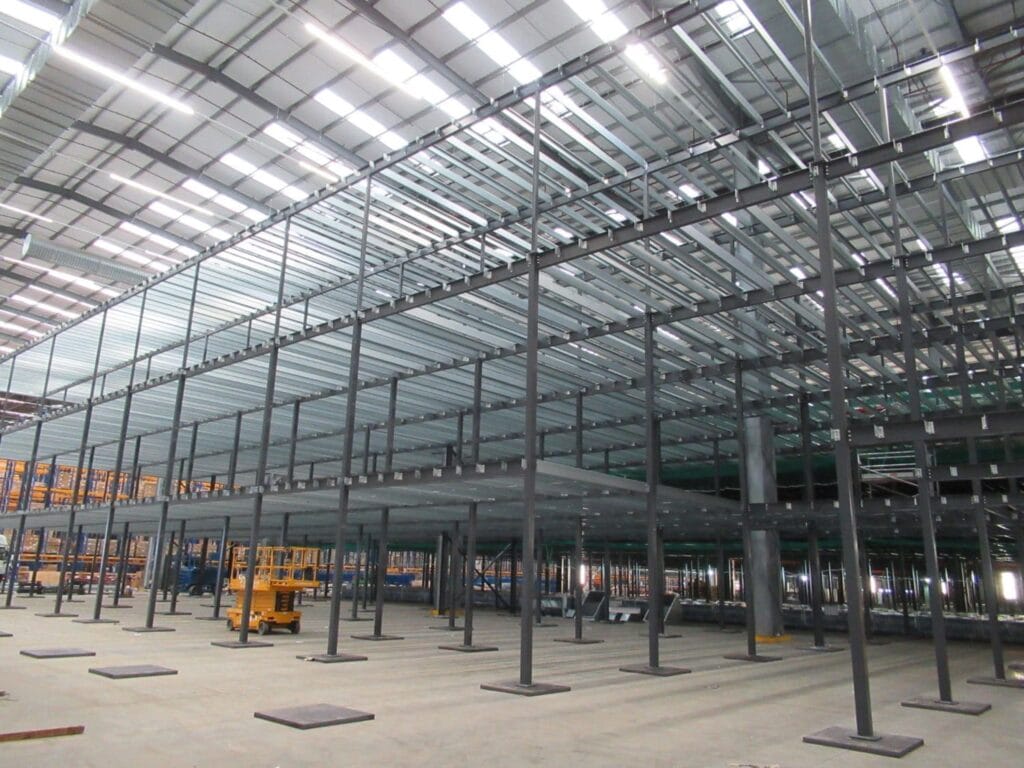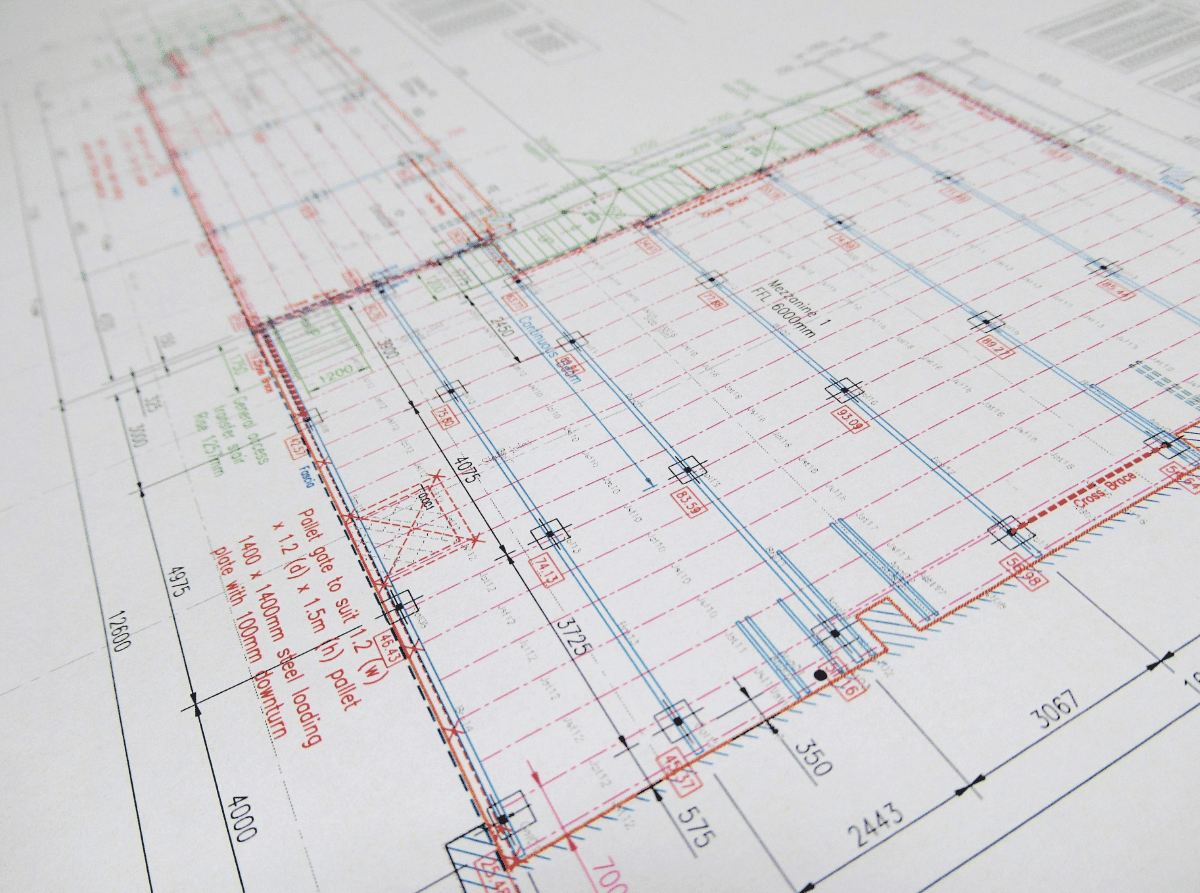Developing your existing business site doesn’t have to take a lifetime. Whether you need space to accommodate more stock, improve productivity or house assembly lines – a mezzanine floor provides a cost effective and fast solution.
Rather than enduring the costly and time consuming experience of uprooting from your current premises and finding somewhere new, the process of installing a mezzanine floor is relatively stress-free. Instead of dealing with a number of estate agents, solicitors and other points of contact – any client that has a Hi-Level Mezzanine floor installed will benefit from having a single point of contact throughout the whole process and will benefit from well trained, experienced advisers throughout.


Design
Mezzanine floors come in all shapes and sizes and serve a number of different purposes, but one thing they need to share in common is a well-planned design and fabricated in accordance with CE Marking. Attention to detail is important and as such all of our floors are designed by Chartered Engineers. Our in-house designed computer system can assess all requirements and produce the most efficient floor design possible which can then be turned into detailed CAD drawings. All of our floors meet requirements for building regulations
Features
Under the law, employers are responsible for the health and safety of their workers. If employees are going to conduct their day to day duties on mezzanine flooring then it is important that an employer considers any potential risks or possible threats to their welfare. One such preventative measure that can be put in place is the use of edge protection. Protective handrails are required on all exposed edges of mezzanine floors; this protects staff from injuring themselves while working at a height and also stops any important products or machinery from being damaged by a fall. Mesh panels may also help prevent smaller items from falling over the sides.
Of course, safety isn’t the only reason to make adjustments to mezzanine flooring. A business might wish to make adjustments for visual reasons too.
If a business wants to make a big impression then company colours can be added to any ancillary items such as staircases, handrail and pallet gates which are powder coated to give a high corrosion resistance. This is often important in retail environments where a brand image is of high importance.
As expected with a raised floor that makes the most of unused vertical space, staircases and handrails are integral. It is important to consider what kind of staircase would best fit the needs of a specific business as an industrial environment would require a very different design and finish to that of the staircase of a retail environment.
Pallet gates come in three different designs; either light weight, fail-safe roll-over , ‘sliding trombone’ type or a swing gate. They are ideal for protecting staff from open areas, for example when they are loading standard size pallets. Pallet gates are robust and require very little maintenance.
When it comes to the decking of a mezzanine floor there are a variety of options but particle board, durbar plate and forge-welded gratings are among the most popular types of flooring available and suit all kinds of industries.
38mm Particle Board
38mm particle board is the most popular. It is a high density board and may come with optional moisture resistant, wear resistant and non-slip surface features. Moisture resistance may be particularly important for warehouses that suffer from leaks or spills.
Durbar Plate
Durbar plate is a hot-rolled structural steel floor plate that has an evenly distributed rand raised pattern. It copes well with heavy loads and the textured nature of the raised patterns give it extra grip.
Forge-Welded Gratings
For plant platforms, gangways and transfer aisles, forge-welded gratings are often a good choice.
Planning Permission And Building Regulations
Mezzanine floors are generally immune to planning permission as long as any proposed changes are internal and each floor is less than 200m². However, they do need to meet building regulations, so it is important that a supplier takes full responsibility to ensure that the mezzanine flooring meets with current regulations – fire escapes, disabled access, protection from fire, etc.
Building regulations require that any elevated areas within a warehouse, such as mezzanine floors require an ‘ambulant disabled staircase’. These staircases have specific requirements relating to tread, size of steps, landings and handrails and as such it is advised to consult a specialist to ensure a staircase meets the necessary legal requirements.
Fire safety plays a big part in the construction of a mezzanine floor. It aims to slow the spread of fire and maintain structural integrity so as to allow enough time for employees to escape and fire fighters to rescue anyone trapped or in need of assistance. Fire protection can be achieved through a number of methods which can give early warning, prevent fire and slow its growth, such as:
- Suspended ceilings
- Column casings
- Cavity barriers
- Bulkheads / fascias
- Staircase enclosures
- Fire walls
- Sprinkler systems
- Smoke detection systems
Quality Standards
Production management systems – like Hi-level’s iQD, ensure that the most efficient design is produced based on a business’s unique set of requirements. It creates fast CAD draughting, details output and puts together accurate production scheduling based on manufacturing and installation team availability as well as working from current steel prices to give an accurate quote to a customer.
Installation Process
The process of installing a mezzanine floor doesn’t need to be lengthy and by choosing a company with in-house experts a business can have a speedy transition from quote to installation with a minimum of fuss.
During the first stages, site surveys and inspections are conducted and qualified-surveyors will look over the potential site to understand its requirements. A computerised production management system is then used to produce accurate quotations, production schedules, management information, detailed CAD drawings, materials procurement, manufacturing drawings and installation scheduling.
Once all schedules, quotes and design plans are agreed upon the installation team who will install the mezzanine flooring will then be booked.
After clearance is given in relation to building regulations, manufacturing will commence. Once the parts are ordered and produced they are delivered to the site in time for the installation teams to erect the full structure. Final ‘snagging’ concludes the installation with any necessary tweaks and changes before customer satisfaction forms are signed and the site is left clean and tidy ready for work to recommence.
For more information about installing a mezzanine floor, call us on 01730 233223
For other uses of mezzanine floors, please have a read of our guide to the uses of a mezzanine floor






